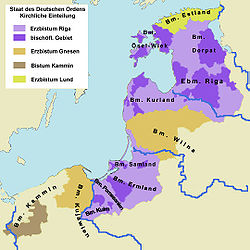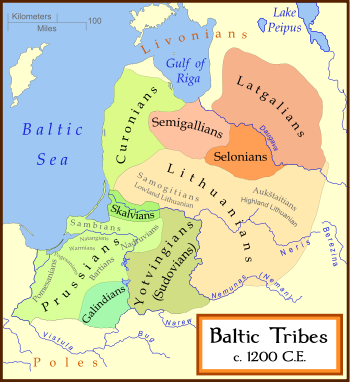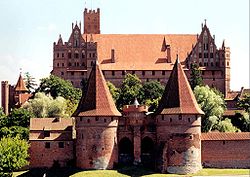- Prussia (region)
-
A cropped image of Prussia from "Spread of German settlements to the Eastward, 800-1400". (Full map.)

Prussia (Old Prussian: Prūsa) is a historical region in Central Europe extending from the south-eastern coast of the Baltic Sea to the Masurian Lake District. It is now divided between Poland, Russia, and Lithuania. The former German state of Prussia derived its name from the region.
Contents
Prehistory
Parts of the Baltic region retained large wilderness areas for longer than anywhere else in Europe. In prehistory, the east of the area was inhabited by the Eastern Balts, whilst the Western Balts inhabited the Sambian peninsula and the areas to the west. Over time, the Western Balts consolidated into the Old Prussian nation. The Eastern Balts of the area, including the Curonians, consolidated into (a part of) the Latvian and Lithuanian nations.
About 350 BC Pytheas called the territory Mentenomon and the inhabitants Guttones, neighbors of the Teutones. A river to the east of the Vistula was called the Guttalus (also Guthalus) and was assumed to have been either the Memel, the Alle, or the Pregel.
Vikings in Prussia
The Vikings started to penetrate the Eastern shores of the Baltic Sea in the 7th and 8th centuries. The largest trade centres of the Prussians, such as Truso and Kaup, seem to have absorbed a number of Norsemen. Prussians used the Baltic Sea as a trading route, frequently traveling from Truso to Birka (present-day Sweden).
At the end of the Viking Age, the sons of Danish king Harald Bluetooth and Canute the Great launched several expeditions against the Prussians. They destroyed many areas in Prussia, including Truso and Kaup, but failed to dominate the population totally. A Viking (Varangian) presence in the area was "less than dominant and very much less than imperial."[1]
Old Prussians
According to a legend, recorded by Simon Grunau, the name "Prussia" is derived from Pruteno (or Bruteno), the chief priest of Prussia and brother of the legendary king Widewuto, who lived in the 6th century. The regions of Prussia and the corresponding tribes are said to bear the names of Widewuto's sons — for example, Sudovia is named after Widewuto's son Sudo. In the first half of the 13th century, Bishop Christian of Prussia recorded the history of a much earlier era. Adam of Bremen mentions Prussians in 1072.
The Old Prussians spoke a variety of languages, with Old Prussian belonging to the Western branch of the Baltic language group. Related, but not mutually intelligible, are the modern representatives of the Baltic languages: Latvian and Lithuanian, from the East Baltic branch. Roman historians had documented the Prussian tribes as easterners, with Tacitus' referring to them as the Aesti.[2]
The territory was identified as Brus in the 8th century map of the Bavarian geographer Adalbert of Prague. He went to the area as a Christian missionary, accompanied by armed guards, sent by Boleslaw I of Poland to convert the Prussians. He was killed by a Prussian pagan priest in 997.[3]
Attempts at conquest of Prussia
After the state of the Polans was established in the 10th century, they tried to conquer the land of the Prussians. Boleslaw I Chrobry sent Adalbert of Prague in AD 997 on a military and Christianizing mission. In 1015, Boleslaw sent soldiers again, with some short-lived success, gaining regular paid tribute from some Prussians in the border regions, but it did not last. Polish rulers sent invasions to the territory in 1147, 1161/1166 and a number in the early 13th century. All these were repelled by the Prussians, but the Culmer Land region became a contested area exposed to frequent raids.
Teutonic Knights
Main article: Teutonic Order state Catholic dioceses in Prussia and adjacent areas. Situation after the conquest in the late 13th century. Areas in purple under control of the Monastic State of the Teutonic Knights
Catholic dioceses in Prussia and adjacent areas. Situation after the conquest in the late 13th century. Areas in purple under control of the Monastic State of the Teutonic Knights
In the 13th century Konrad of Masovia had called for Crusades and tried for years to conquer Prussia, but failed. Thus the pope set up further crusades. Finally he invited the Teutonic Knights to fight the inhabitants of Prussia in exchange for a fief of Chełmno Land. Prussia was conquered by the Teutonic Knights during the Prussian Crusade and administered within their Teutonic Order state. After the acquisition of Pomerelia in 1308/10, the meaning of the term Prussia was widened to include areas west of the Vistula.
With the Second Peace of Thorn (1466), Prussia was divided into eastern and western lands. The western part became the autonomous Royal Prussia within the Kingdom of Poland, while the eastern part of the monastic state became a fief of Poland. In 1492, a life of Dorothea of Montau, published in Marienburg (Malbork), became the first printed publication in Prussia.
Early modern era
 Map by Caspar Henneberg, Elbing 1576: Duchy and Royal Prussia originally with same color (for the duchy the color was added later)
Map by Caspar Henneberg, Elbing 1576: Duchy and Royal Prussia originally with same color (for the duchy the color was added later)
 Prussia after 1466: light grey – Duchy of Prussia.
Prussia after 1466: light grey – Duchy of Prussia.
colored – Royal Prussia with its Voivodeships in personal union with the Polish-Lithuanian CommonwealthDuring the Protestant Reformation, endemic religious upheavals and wars occurred, and in 1525, the last Grand Master of the Teutonic Knights, Albert of Brandenburg, a member of a cadet branch of the House of Hohenzollern, adopted the Lutheran faith, resigned his position, and assumed the title of "Duke of Prussia." In a deal partially brokered by Martin Luther, the Duchy of Prussia became the first Protestant state and a vassal of Poland. The ducal capital of Königsberg, now Kaliningrad, became a centre of learning and printing through the establishment of the Albertina University in 1544.
Ducal Prussia passed to the senior Hohenzollern branch, the ruling Margraves of Brandenburg, in 1618, and Polish sovereignty over the duchy ended in 1657 with the Treaty of Wehlau. Because Ducal Prussia lay outside of the Holy Roman Empire, Frederick I achieved the elevation of the duchy to the Kingdom of Prussia in 1701. The former ducal lands became known as East Prussia. Royal Prussia was annexed from the Polish-Lithuanian Commonwealth by the Kingdom of Prussia during the 18th century Partitions of Poland and administered within West Prussia.
Modern era
Main articles: Kingdom of Prussia, Province of Prussia, West Prussia, East Prussia, Free State of Prussia, Polish Corridor, Pomeranian Voivodship, Warmian-Masurian Voivodeship, and Kaliningrad OblastThough the Kingdom of Prussia was a member of the German Confederation from 1815 to 1866, the provinces of Posen and Prussia were not a part of Germany[4] until the creation of the German Empire in 1871 during the unification of Germany.
By the Treaty of Versailles, some territories of West Prussia and the Province of Posen that had belonged to the Prussian kingdom[5] and the German Empire were ceded to the Second Polish Republic. East Prussia, minus the Memelland, received some districts of former West Prussia and remained within the German Weimar Republic.
According to the Potsdam Conference in 1945 after World War II, the Prussian region was divided between Poland and the Soviet Union. Western Prussia (West Prussia / Royal Prussia) and the East Prussian lands of Warmia and Masuria are in Poland, while northern East Prussia was divided between the Russian and Lithuanian Soviet republics. The German state of Prussia, of which the Prussian region was but a small part, was dissolved in 1947.
Notes
- ^ Gwyn Jones. A History of the Vikings. Oxford University Press, 2001. ISBN 0-19-280134-1. Page 244.
- ^ Although the Aesti are generally accepted to be the Prussians, primarily based on their association with amber, this is by no means universally accepted. See Aesti.
- ^ "St. Adalbert", The Catholic Encyclopedia, New York: Robert Appleton Company, 1907
- ^ However, the constitution of the short-lived Frankfurt Parliament incorporated Prussia and the western and northern parts of Posen into Germany from 1848 to 1851.
- ^ Since the Partitions of Poland which began in 1772.
External links
- Partial Map of Prussia by Gerard Mercator, Atlas sive cosmographica., Amsterdam 1594
- Partial Map of Prussia by Kasper Henneberger, Koenigsberg 1629
- Map of Old Prussia by K. Henneberger, 17th c.
- Map of Prussia by K. Henneberger in: Christoph Hartknoch, Alt- und neues Preussen..., Frankfurt 1684
- Map of Prussia and Freie Stadt Danzig from 18th c.
- Map of East Prussia K. Flemming, F. Handtke, Głogów ca. 1920, after Treaty of Versailles removed Memel area from Germany.
- Dawne mapy i atlasy
Categories:- History of Prussia
- Historical regions in Russia
- Historical regions in Poland
- Historical regions in Lithuania
- History of Poland
- History of Germany
- Divided regions
Wikimedia Foundation. 2010.



